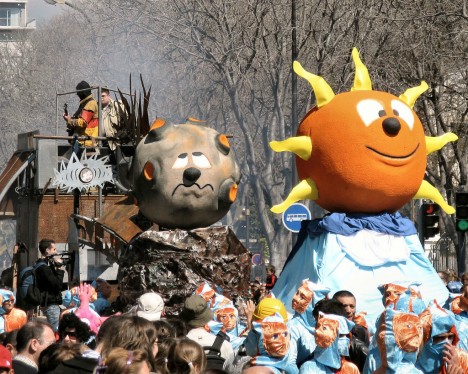Mardi Gras – Pomp, Gaiety, Splendour!
France – a nation known for its vintage charms, romantic getaways and gorgeous women has much more up its mischievous sleeve than what meets the naked eye! But of course, it’s no surprise that Frenchmen have a deep-seated, enthusiastic passion for all things celebration; from formal tea parties with delectable pâtisserie to fully-fledged memorabilia of song, dance and rejoice!
Hence, the annual commemoration of Mardi gras is no exception, as it presents everything from feasts to parades! Literally meaning ‘Fat Tuesday’ in English, Mardi gras is known so since it takes place on the Tuesday that falls shortly prior to Ash Wednesday (the Wednesday that marks the onset of the Lent period, where Christians of all denominations observe sessions of fasting for the following 40 days i.e. till Easter Sunday). Since Lent emphasizes on religious virtues, a grand carnival is organized a day before for one and all!

Mardi gras (Carnival), Marseille, France by Say-Mars-Say-Yeah
Apart from the fun and games, what’s most interesting about this colourful carnival is its diversified history that led to its origin! The story goes –
- That a festival resembling the new-generation Mardi gras was organized every year somewhere during mid-February by the ancient Romans during the second century AD (before the settlement of Catholicism in Europe).
- Once Christianity was established, church priests decided that integrating this particular festival in synchronization to the religious agenda would deem suitable for all individuals, providing a means of enjoyment prior to observing Lent.
So, here we are! Ever since then Mardi gras is dedicatedly celebrated to cheer up the lives of many a person! If you closely observe the flamboyant parades that generally take place in most leading French cities during this season, some traits are common, such as –
- Flaunting a fattened ox in due course of the processions to signify delightfully succulent meaty treats!
- The three primary colours denoting a ‘mascot’ for Mardi gras: purple (for justice), green (for faith) and gold (for power). The finest of outfits and accessories donned by performers, especially masks are seen to be crafted with these three shades!
Due to the rise in popularity of Mardi gras in France, this festival slowly gained recognition in the American state of Louisiana too – primarily in its city of New Orleans. How exactly Mardi gras was introduced to America is not exactly known, for there were arrays of different tales in reference to it. Some say that in 1699, a French explorer named Sieur d’Iberville set up camp 60 miles south of New Orleans and introduced Mardi gras to its local natives. More folklore narrates that a bunch of students who had returned from Paris to Louisiana in 1827 paraded around the streets clad in costumes of purple, green and gold, and hence won the hearts of neighbouring residents, who then began to follow suit.
Needless to say, no matter how, when, why and where Mardi gras originated, the fact that it’s a festival enjoyed by all is enough to consider to keep its tradition going on for generations to come!
Author’s Bio
Megan Tyler is a journalist and a veteran content writer. She has experience in copywriting and journalism. Presently she is exploring and writing on various subjects but at the moment appended with Holiday in Namibia.














